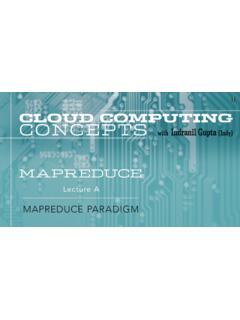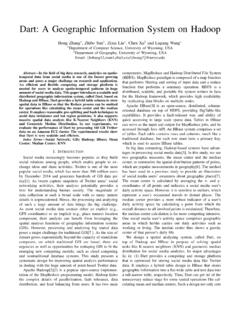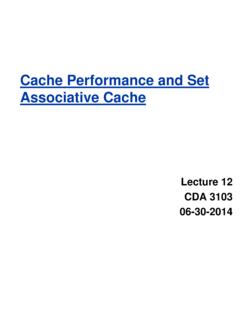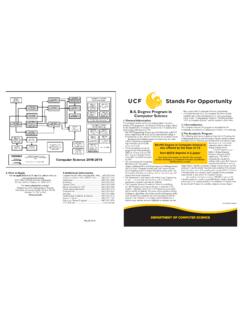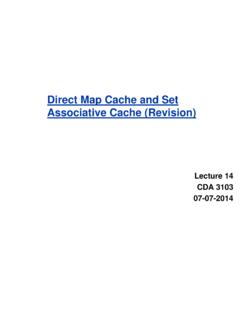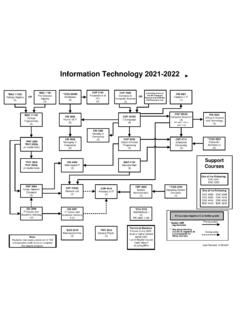Transcription of Fault Tree Analysis - University of Central Florida
1 Fault tree Analysis Clifton A. Ericson II. 1 C. Ericson 1999. Fault tree Analysis Clifton A. Ericson II. Sept. 2000. or 2 C. Ericson 1999. Fault tree Analysis Outline n Overview n History n Basic Process n Definitions n Construction n Mathematics n Evaluation n Pitfalls n Rules n Examples 3 C. Ericson 1999. Fault tree Analysis FTA Overview 4 C. Ericson 1999. Introduction To design systems that work correctly we often need to understand and correct how they can go wrong.. Dan Goldin, NASA Administrator, 2000. FTA identifies, models and evaluates the unique interrelationship of events leading to : Failure Undesired Events / States Unintended Events / States 5 C. Ericson 1999. FTA - Description l Tool n evaluate complex systems n identify events that can cause an Undesired Event n safety, reliability, unavailability, accident investigation l Analysis n identifies root causes n deductive (general to the specific). n provides risk assessment F cut sets (qualitative). F probability (quantitative).
2 6 C. Ericson 1999. FTA - Description l Model A picture is worth a 1,000 words! n visual n displays cause-consequence relationships n Fault events, normal events, paths n probability l Methodology n defined, structured and rigorous n easy to learn, perform and follow n utilizes Boolean Algebra, probability theory, reliability theory, logic n follows the laws of physics, chemistry and engineering 7 C. Ericson 1999. Example FT. System Battery Light A B. System Undesired Event: Light Fails Off Light Fails FT Model Off Bulb Switch A Switch B Battery Wire Fails Fails Fails Open Fails Open Fails Open A B C D E. Cut Sets Event combinations that can cause Top Undesired Event to occur CS Probability A PA= B PB= C PC= D PD= E PE= 8 C. Ericson 1999. FTA Application Why l Root Cause Analysis n Identify all relevant events and conditions leading to Undesired Event n Determine parallel and sequential event combinations n Model diverse/complex event interrelationships involved l Risk Assessment n Calculate the probability of an Undesired Event (level of risk).
3 N Identify safety critical components/functions/phases n Measure effect of design changes l Design Safety Assessment n Demonstrate compliance with requirements n Shows where safety requirements are needed n Identify and evaluate potential design defects/weak links n Determine Common Mode failures 9 C. Ericson 1999. FTA -- Coverage l Failures l Fault Events l Normal Events l Environmental Effects l Systems, subsystems, and components l System Elements n hardware, software, human, instructions l Time n mission time, single phase, multi phase l Repair 10 C. Ericson 1999. FT Strengths l Visual model -- cause/effect relationships l Easy to learn, do and follow l Models complex system relationships in an understandable manner n Follows paths across system boundaries n Combines hardware, software, environment and human interaction l Probability model l Scientifically sound n Boolean Algebra, Logic, Probability, Reliability n Physics, Chemistry and Engineering l Commercial software is available l FT's can provide value despite incomplete information l Proven Technique 11 C.
4 Ericson 1999. FTA Misconceptions l Not a Hazard Analysis n root cause Analysis vs. hazard Analysis n deductive vs. inductive l Not an FMEA. n FMEA is bottom up single thread Analysis l Not an Un-Reliability Analysis n System Integrity vs. Availability n not an inverse Success tree l Not a model of all system failures n only includes those failures pertinent to the top Undesired Event l Not 100% fidelity model of reality only n estimate, not an exact duplicate n perception of reality 12 C. Ericson 1999. FTA Application -- When l Required by customer l Required for certification l Necessitated by the risk involved with the product (risk is high). l Accident/incident/anomaly investigation l To make a detailed safety case for safety critical system l To evaluate corrective action or design options l Need to evaluate criticality, importance, probability and risk l Need to know root cause chain of events l To evaluate the effect of safety barriers l Determine best location for safety devices (weak links).
5 13 C. Ericson 1999. FTA Is Not For Every Hazard Haz1 3C. Haz2 2D. Haz3 1B FTA - Inadvertent Weapon Arm Haz4 2C. Haz5 3B.. Haz77 1C FTA - Inadvertent Weapon Launch .. Haz100 2C. Only do FTA on Safety Critical hazards. 14 C. Ericson 1999. Example Applications l Evaluate inadvertent arming and release of a weapon l Calculate the probability of a nuclear power plant accident l Evaluate an industrial robot going astray l Calculate the probability of a nuclear power plant safety device being unavailable when needed l Evaluate inadvertent deployment of jet engine thrust reverser l Evaluate the accidental operation and crash of a railroad car l Evaluate spacecraft failure l Calculate the probability of a torpedo striking target vessel l Evaluate a chemical process and determine where to monitor the process and establish safety controls 15 C. Ericson 1999. FTA Timeline l Design Phase n FTA should start early in the program n The goal is to influence design early, before changes are too costly n Update the Analysis as the design progresses n Each FT update adds more detail to match design detail n Even an early, high level FT provides useful information l Operations Phase n FTA during operations for root cause Analysis n Find and solve problems (anomalies) in real time Conceptual Preliminary Final Deployment Design Design Design Initial Update Update Final Operations FTA FTA FTA FTA FTA.
6 16 C. Ericson 1999. FTA Summary Undesired Event B. System V x A C. V V. Fault tree UE. Y. Critical Cut Set = A B C Y A C. Probability = x 10-7. B. 17 C. Ericson 1999. FTA Summary l FTA is an Analysis tool n Strengths methodical, structured, graphical, quantitative, easy to model complex systems n Coverage hardware, software, humans, procedures, timing n Like any tool, the user must know when, why and how to use it correctly l FTA is for system evaluation n Safety hazardous and catastrophic events n Reliability system unavailability n Performance unintended functions l FTA is for decision making n Root cause Analysis n Risk assessment n Design assessment 18 C. Ericson 1999. FTA History 19 C. Ericson 1999. FTA Historical Stages The Beginning Years (1961 1970). l H. Watson of Bell Labs, along with A. Mearns, developed the technique for the Air Force for evaluation of the Minuteman Launch Control System, circa 1961. l Recognized by Dave Haasl of Boeing as a significant system safety Analysis tool (1963).
7 L First major use when applied by Boeing on the entire Minuteman system for safety evaluation (1964 1967, 1968-1999). l The first technical papers on FTA were presented at the first System Safety Conference, held in Seattle, June 1965. l Boeing began using FTA on the design and evaluation of commercial aircraft, circa 1966. l Boeing developed a 12-phase Fault tree simulation program, and a Fault tree plotting program on a Calcomp roll plotter l Adopted by the Aerospace industry (aircraft and weapons). 20 C. Ericson 1999. FTA Historical Stages The Early Years (1971 1980). l Adopted by the Nuclear Power industry l Power industry enhanced codes and algorithms l Some of the more recognized software codes include: n Prepp/Kitt, SETS, FTAP, Importance and COMCAN. 21 C. Ericson 1999. FTA Historical Stages The Mid Years (1981 1990). l Usage started becoming international, primarily via the Nuclear Power industry l More evaluation algorithms and codes were developed l A large number of technical papers were written on the subject (codes & algorithms).
8 L Usage of FTA in the software (safety) community l Adopted by the Chemical industry 22 C. Ericson 1999. FTA Historical Stages The Present (1991 1999). l Continued use on many systems in many countries l High quality Fault tree Commercial codes developed that operates on PC's l Adopted by the Robotics and Software industry 23 C. Ericson 1999. FTA Definitions 24 C. Ericson 1999. FT Building Blocks Node Types: l Basic Events (BE). l Gate Events (GE). l Condition Events (CE). l Transfer Events (TE). 25 C. Ericson 1999. FT Node Types Basic Event (BE). l Failure Event n Primary Failure - basic component failure (circle symbol). n Secondary Failure - failure caused by external force (diamond symbol). l Normal Event n An event that describes a normally expected system state n An operation or function that occurs as intended or designed, such as Power Applied At Time T1 . n The Normal event is usually either On or Off, having a probability of either 1 or 0. n House symbol l The BE's are where the failure rates and probabilities enter the FT.
9 26 C. Ericson 1999. FT Node Types Gate Event (GE). l A logic operator combining input nodes l A gate that permits or inhibits Fault logic up the tree l Five basic types n AND, OR, Inhibit, Priority AND and Exclusive OR. l Represents a Fault state that has further causes to be developed 27 C. Ericson 1999. FT Node Types Condition Event (CE). l A condition attached to a gate event l It establishes a condition that is required in order for the gate event to occur l Three basic types n Inhibit, Priority AND and Exclusive OR. 28 C. Ericson 1999. FT Node Types Transfer Event (TE). l A pointer to a tree branch l Indicates a subtree branch that is used elsewhere in the tree (transfer in/out). l A Transfer always involves a Gate Event node on the tree , and is symbolically represented by a Triangle l The Transfer is for several different purposes: n Starts a new page (for plots). n It indicates where a branch is used numerous places in the same tree , but is not repeatedly drawn (Internal Transfer) (MOB).
10 N It indicates an input module from a separate Analysis (External Transfer). 29 C. Ericson 1999. OR Gate l Causality never passes through an OR gate n The input faults are never the cause of the output Fault n Inputs are identical to the output, only more specifically defined (refined) as to cause Valve Is Closed Valve Is Valve Is Closed Due To Closed Due To H/W Failure S/W Failure 30 C. Ericson 1999. AND Gate l Specifies a causal relationship between the inputs and the output n The input faults collectively represent the cause of the output Fault n Implies nothing about the antecedents of the input faults All Site Power Is Failed Electrical Diesel Backup Battery Backup Power Is Power Is Power Is Failed Failed Failed 31 C. Ericson 1999. Inhibit Gate D. Y1. C. A B. Both C and Y1 are necessary to cause D. Y1 is a condition or probability Pass through if condition is satisfied Essentially an AND gate 32 C. Ericson 1999. Transfer Symbols Switch Transfer In Is Open A. Switch Is Open A.
